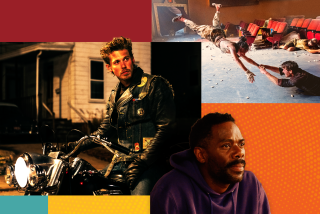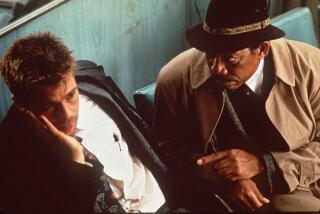How to watch every best picture winner from 1970 through 1979
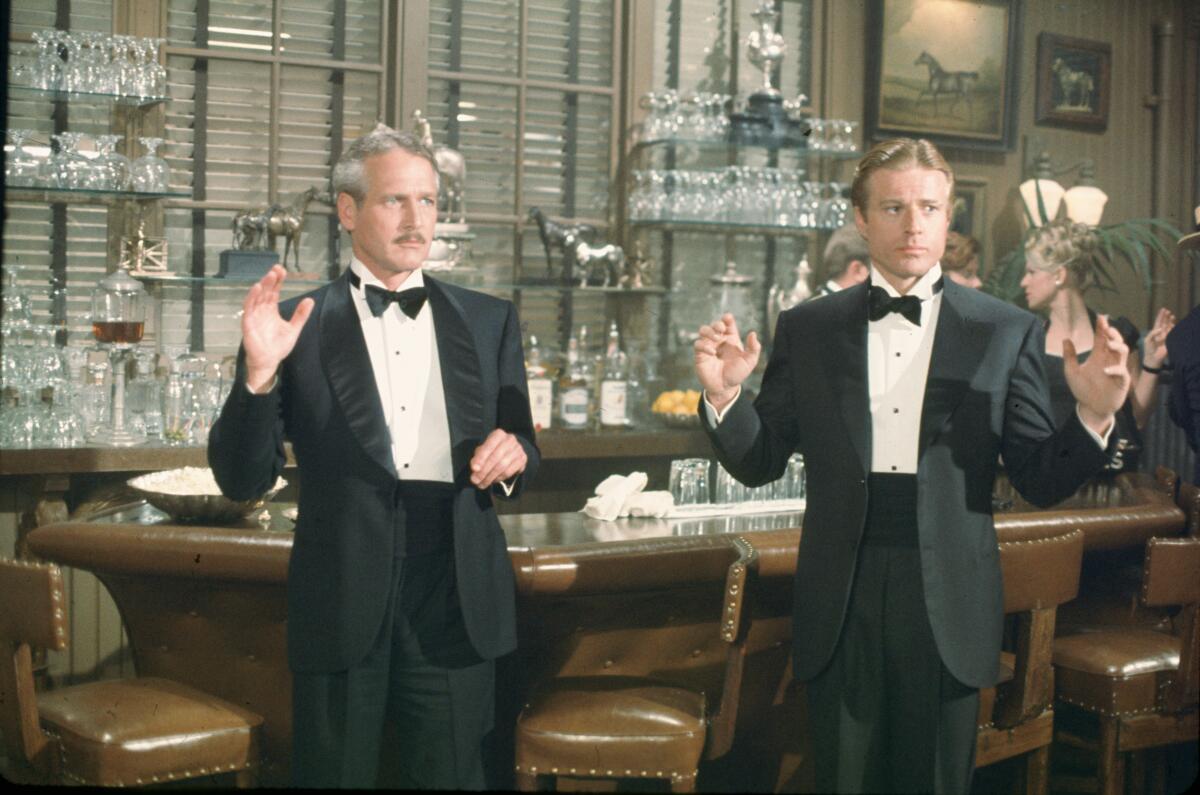
- Share via
As the 1970s began, the oldest baby boomers were young adults and the youngest were in elementary school. The decade’s first best picture winner was the World War II biography “Patton” (1970), co-written by Francis Ford Coppola, who went on to direct Oscar winners “The Godfather” (1972) and “The Godfather Part II” (1974).
“The Deer Hunter” (1978) was the first Vietnam War movie to win the best picture Oscar and “Rocky” (1976) was the first boxing movie to do so.
Also in the ‘70s, the baby boomer generation of Hollywood talent came into their own, including Diane Keaton (“The Godfather,” “The Godfather Part II” and “Annie Hall”); Talia Shire (“The Godfather,” “The Godfather Part II” and “Rocky”); Sylvester Stallone (“Rocky”); Meryl Streep (“The Deer Hunter” and “Kramer vs. Kramer”) and Christopher Walken (“The Deer Hunter”).
How to watch Oscar Best Picture winners through the decades
Intro and 1920s | 1930s | 1940s | 1950s | 1960s | 1970s | 1980s | 1990s | 2000s | 2010s | 2020s (and 2020 nominees)
1970: ‘Patton’
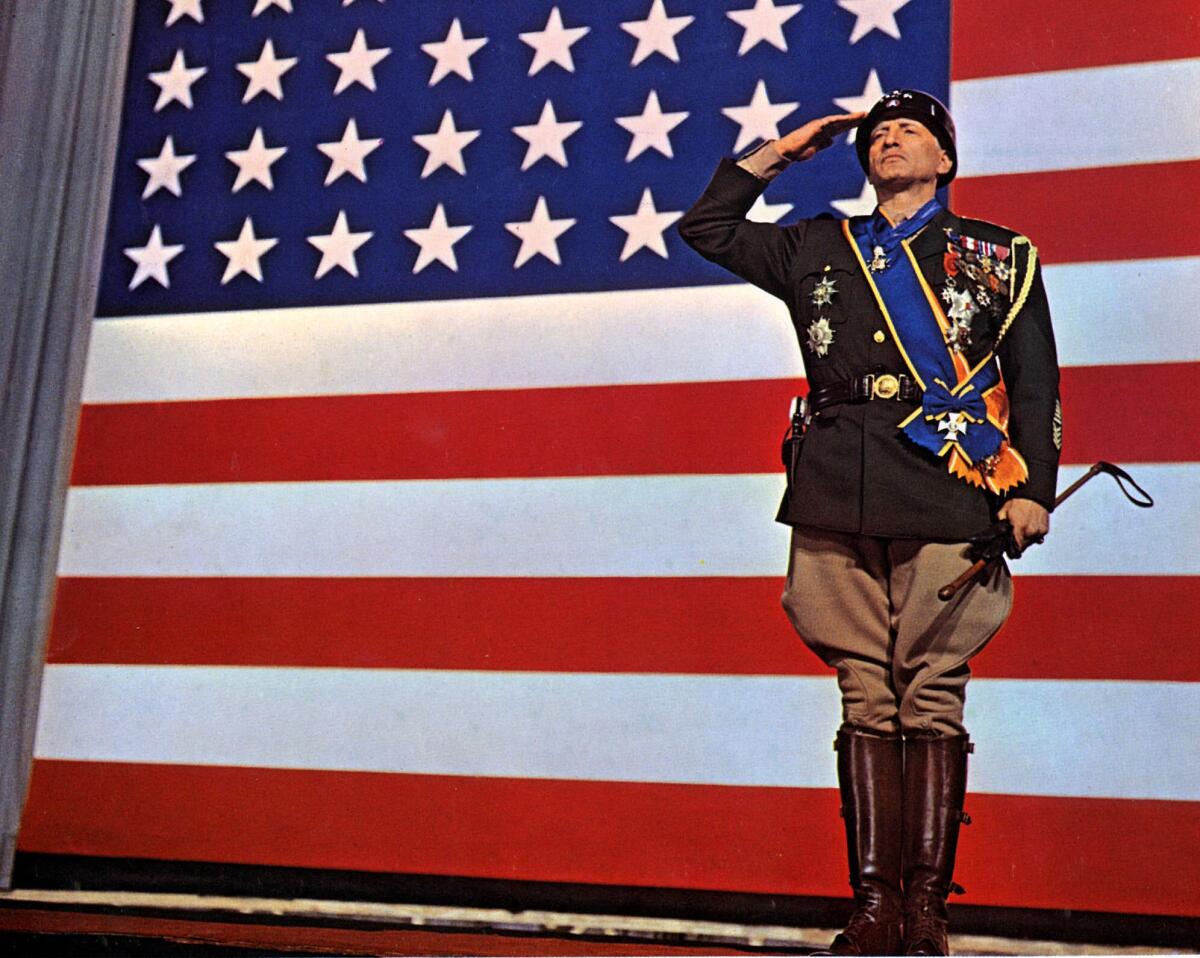
43rd Academy Awards — April 1971
Rating: M/PG.
Running time: 2 hours, 52 minutes.
Streaming: Prime Video: Rent/Buy | Apple TV+: Rent/Buy
Across the great width of the screen stretches a 48-star American flag. It is not just vivid, it looks fluorescent, as if it were Day-Glo rather than a projected image.
From the bottom of the frame, seeming to emerge from both the flag and from time, dwarfed even by a stripe of the flag which thus appears to be even larger, a figure strides commandingly toward the audience. (The effect is strikingly three-dimensional, and this, too, is usefully symbolic.)
He is George C. Scott as Gen. George S. Patton Jr., glistening from helmet to boots, sashed and bemedaled, ivory-handled pistols snug at the hips, and he talks to us as to a theater-full of GIs just finishing combat training in Louisiana about to embark for the war in Africa.
What he says is warrior talk — proud, patriotic, passionate, profane. A newspaper probably couldn’t print it in full, but it is what the general said, to the last powerful cuss-word. The speech will thrill those for whom the glories of patriotic battle can never dim, and will chill those who do not think themselves less patriotic because they find war an ugly and unavailing abomination.
It makes a stunning beginning to a remarkable and complex movie which at last will give perfect comfort neither to the Hawks nor to the Doves. For Patton is a portrait, not an argument, and that is its strength and salvation.
The script, written by Francis Ford Coppola and Edmund H. North, follows Patton from his first appearance in the desert war of North Africa, through Sicily and Europe to the moment he is relieved of command of the Third Army. (Read more) — Charles Champlin
1971: ‘The French Connection’

44th Academy Awards — April 1972
Rating: R.
Running time: 1 hour, 43 minutes.
Streaming: Prime Video: Rent/Buy | Apple TV+: Rent/Buy
“The French Connection” is by a long revolver shot the best cops-and-robbers movie since “Bullitt.” In fact, everything that made “Bullitt” a success makes “The French Connection” even more successful. There is a chase more exciting than that famous chase through San Francisco (which I’d have said couldn’t be improved upon) more exciting because we seem to be participants, not spectators.
This one pits a detective in a commandeered car against an elevated train commandeered by a killer. The scene is Brooklyn and the horn-blowing, fender-crunching, slewing, shrieking, track-clacking action is heart-stopping. As they say these days, FAN-tastic.
No studio setups were used and “The French Connection” has the gritty authenticity of a first-rate documentary. When it looks cold outside, baby, you know it was. It is a police drama and, like “Bullitt” only more so, it takes it for granted that detectives are human beings with the usual quota of frailties, but also (if we are lucky) a compensating, compulsive drive to catch criminals.
The story is based on an actual case in which two Manhattan narcotics detectives, working initially on a hunch and their own time, patiently watched a suspect until he led them to a haul of heroin worth $32 million at street prices, the largest single capture in history. The case made a best seller for Robin (“The Green Berets”) Moore. The detectives are played by Gene Hackman and Roy Scheider, and they create an often unflattering credibility which is powerful indeed. (Read more) — Charles Champlin
1972: ‘The Godfather’
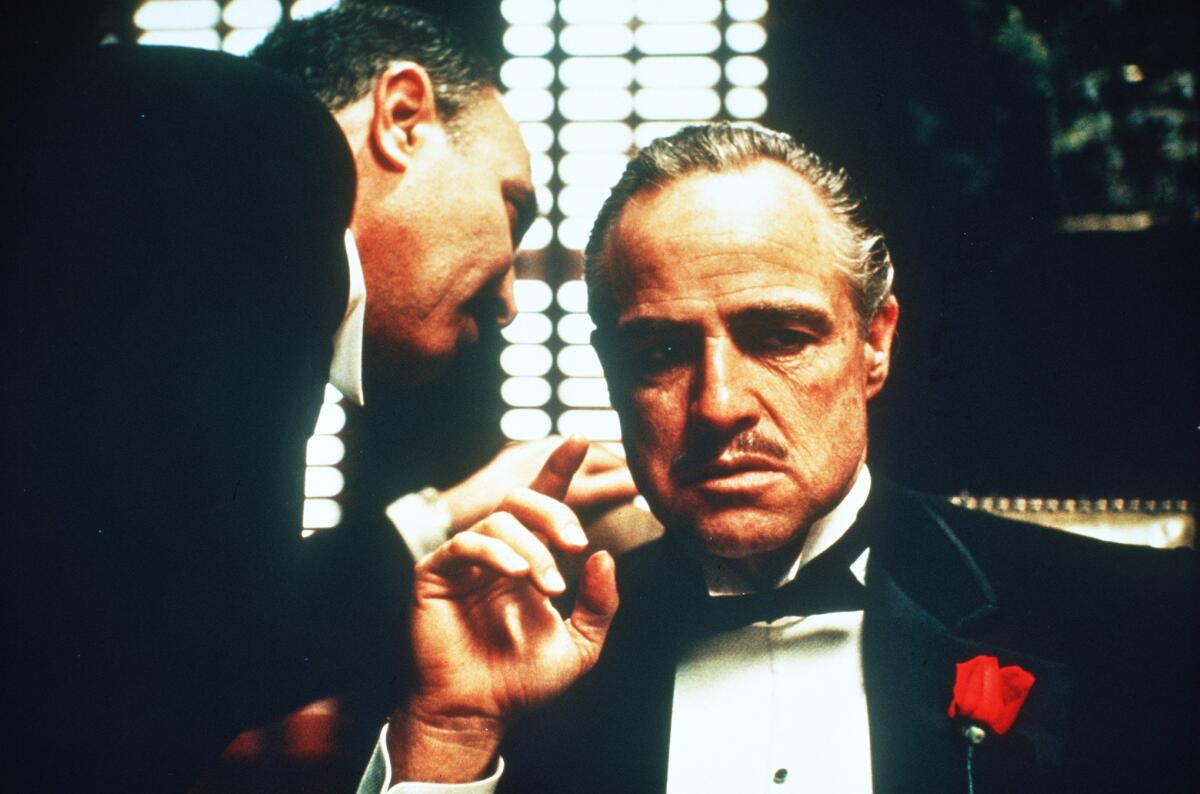
45th Academy Awards — March 1973
Rating: R.
Running time: 2 hours, 55 minutes.
Streaming: Peacock: Included | Prime Video: Rent/Buy | Apple TV+: Rent/Buy
Mario Puzo’s novel was an irresistible, eventful, easy to digest, hard to put down bestseller (a half million hardbacks, 10 million paperbacks) and Puzo and director Francis Ford Coppola, who co-authored the script, have delivered the novel just about as faithfully as a novel can be delivered.
Do you like the side action upstairs in the bedroom during the wedding? You got it. Liked the horse head bit? You got it. The restaurant caper with the crooked police captain? You got it, you got it.
“The Godfather” is an entertainment, not a documentary, however close it may come to some of the realities behind the headlines. Because it generates an aura of considerable believability, it is a saving grace of the movie that it keeps its balance.
Marlon Brando, his voice a reedy whisper, his jowls stuffed to a patriarchal sag, his body stiffened with years, his hair etched with gray, gives a performance which is at once a tour de force and so economical that it seems to be understated. He does not so much appear to act as to establish and exist as a presence, a strength. His Don Corleone is a portrayal which reveals more than pages of dialogue could help to convey.
Hardly less persuasive is Al Pacino, who is first-rate as a young addict in “Panic in Needle Park” and who as the don’s son, Michael, drawn reluctantly into the family affairs, seems to change from within, even as we watch him, from the nice normal guy to an ice-hearted and methodical murderer who can impassively serve as godfather at a christening while his rivals are being systematically gunned down in at least two states. Pacino makes Michael an even nastier piece of business than his father had been, colder and, once committed, less touched by a common humanity. (Read more) — Charles Champlin
1973: ‘The Sting’
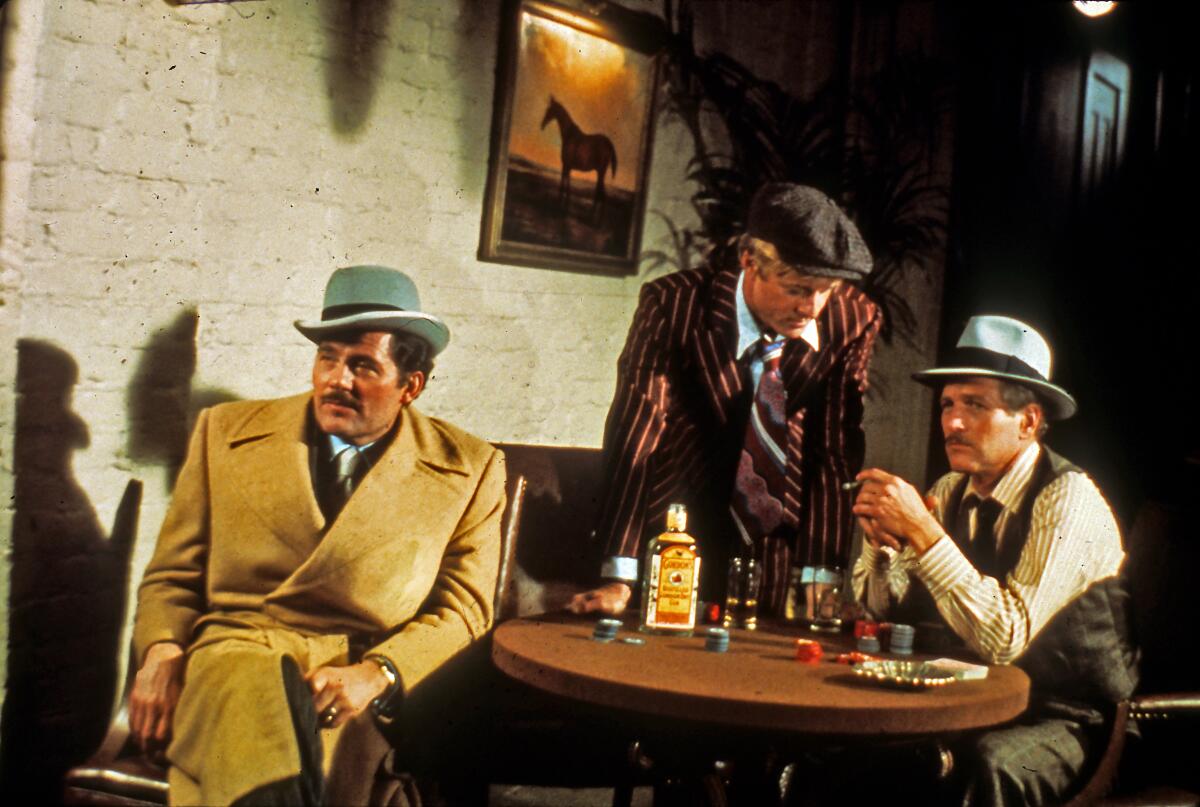
46th Academy Awards — April 1974
Rating: PG.
Running time: 2 hours, 9 minutes.
Streaming: Prime Video: Rent/Buy | Apple TV+: Rent/Buy
It’s taken four years to reassemble “Butch Cassidy and the Sundance Kid’s” winning combination — Paul Newman, Robert Redford and director George Roy Hill — but it’s been worth the wait.
Their new film, ”The Sting,” imaginatively written by 27-year-old former cinema student David S. Ward, is an unalloyed delight, the kind of pure entertainment film that’s all the more welcome for having become such a rarity. What’s more, it’s a triumph of quality Hollywood craftmanship.
The time is September 1936, and the place is Joliet, Ill. Redford, an up-and-coming con man, and his small-time veteran partner (Robert Earl Jones) play the old switch game and find themselves a whopping $11,000 richer. What they don’t know is that their patsy is a numbers runner for a top New York racketeer (Robert Shaw).
In short order Jones is bumped off and Redford, full of revenge is on to Chicago to find Newman, a legendary big-time con man currently on the skids. Inevitably, they team up to “sting” Shaw, an ugly humorless Irishman who “don’t drink, don’t smoke, and don’t chase women.”
How they go about trying to take Shaw in a big con makes for some of the funniest, most outrageous, suspenseful and surprising moments seen on the screen this year. Newman, Redford and Shaw are in top form, and they are backed by a host of character actors typical of beloved ‘30s movies. (Read more) — Kevin Thomas
1974: ‘The Godfather Part II’
47th Academy Awards — April 1975
Rating: R.
Running time: 3 hours, 20 minutes.
Streaming: Peacock: Included | Prime Video: Rent/Buy | Apple TV+: Rent/Buy
What you could say is that “The Godfather” was such a hard act to follow that they preceded it instead. Actually, what now exists is one six-and-a–half–hour film, of which “The Godfather Part I” was the middle half and of which “The Godfather Part II” now provides the opening and concluding quarters. (I hope one day we’ll be able to see it reparted chronologically.)
The scale on which Francis Ford Coppola and Mario Puzo have told their tale is epic, spanning six decades in three generations, with a glimpse of the fourth. Their commercial success is already established as heroic, and there’s no reason to doubt that “Godfather II” will join the top money makers of all time.
“Godfather II” is quieter, less propulsive, less furiously violet than “Godfather I” and it demonstrably lacks the hypnotic patriarchal figure of Brando as Don Corleone. Still it is compellingly watchable.
It gives us, superbly, the Mafia-dominated Sicily of 1901, from which the don-to-be flees as a small boy after his father, older brother and mother have been murdered by the village chieftain.
I don’t remember the first glimpse of the Statue of Liberty and the cattle-pen chaos of Ellis Island (with impatient clerks improvising names which families would carry for generations) ever caught more authentically.
The young Vito Corleone (clerk-named for his home village) makes his way in the Italian ghetto of lower Manhattan that was to be updated 70 years later in Martin Scorsese’s “Mean Streets.” Indeed, the young Vito is played by Robert De Niro from “Mean Streets” and “Bang the Drum Slowly.”
It is a sensational performance, advancing Corleone from the thin, pale youth working for pennies in a grocery store to the solid leader of his family, returning in triumph to settle the old score in Sicily, parlaying thievery and murder into power and respect. De Niro, hoarse-voiced and imperiously handsome as he grows in assurance, does an amazing job of preparing us for the Brando we remember.
Al Pacino, in yet another outstanding portrayal, moves Michael still further, from the cool and unemotional mastery of all he surveys to the prisoner of his own paranoia — fearful, vengeful, isolated from everything he genuinely loves but too repellent to be pitiful. He has survived a Senate hearing (beautifully familiar) but lost his cover and his respectability. (Read more) — Charles Champlin
1975: ‘One Flew over the Cuckoo’s Nest’
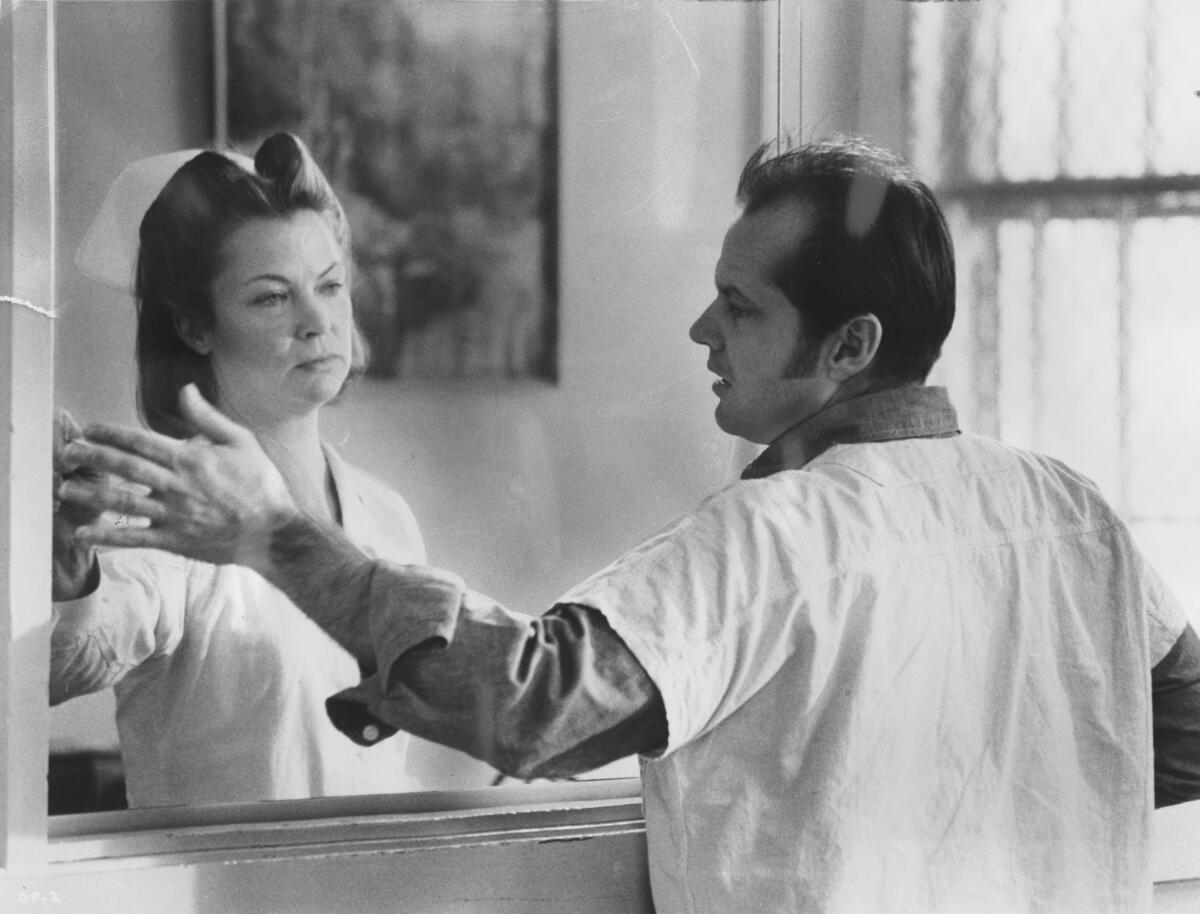
48th Academy Awards — March 1976
Rating: R.
Running time: 2 hours, 13 minutes.
Streaming: HBO Max: Included | Prime Video: Rent/Buy | Apple TV+: Rent/Buy
It is both too easy and impossible to portray madness or any of the variations and degrees of it. I can’t recall ever having seen so many actors convey so well the pain, the innerness, the quick rages and sudden collapses of the walking emotional wounded. In “One Flew Over the Cuckoo’s Nest” the quality of the acting by a cast that is not a cast but a disciplined ensemble is overwhelming. It is as if Jack Nicholson’s fellow inmates at this fictional asylum were reaching up from some pit of despair toward the downstretching hand of sanity/reality. There are moments of touching, times of taking hold. Then the contact is broken and the men slip back into their various retreats from the world and from relationships they can’t handle.
Nicholson is almost the only identifiable actor in the film, and it is in box office terms a star performance likely to make “Cuckoos Nest” one of the largest successes of the year despite its hard contents.
But it is also the finest of all the fine portrayals Nicholson has already given us. Watching him again, it is astounding to see how he can regulate, as he might set the thermostat, the intelligence of the character he is playing.
This subtle, amiable jailbird on temporary leave to the funny farm is saner than the men around him but he’s not necessarily brighter. The eyes narrow with pleasure at his own craftiness and they go blank (if only for a moment) when a kind of fear cuts through the cocky pose. There is an almost continuous succession of scenes in which Nicholson sketches this idler, lover, jokester, manipulator, con man, gambler, loner. (Read more) — Charles Champlin
1976: ‘Rocky’
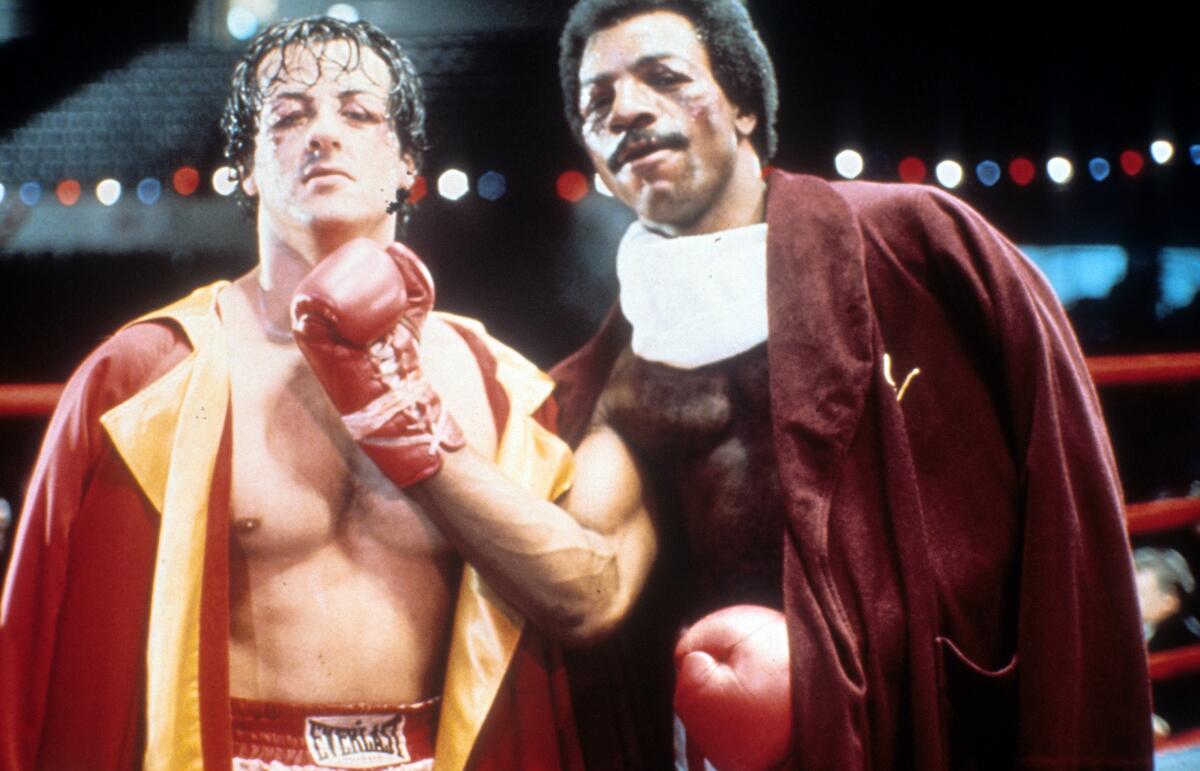
49th Academy Awards — March 1977
Rating: PG.
Running time: 1 hou,r 59 minutes.
Streaming: AMC+: Included | Prime Video: Rent/Buy | Apple TV+: Rent/Buy
A little movie called “Rocky” is very, very special. In one warming stroke it revives and restores the vital tradition of the low-cost and unpretentious movie which creates stars instead of hiring them and which commandeers the rousing affection of its audiences by proclaiming the possibility of love, hope and triumph in the lives of ordinary men and women (who are anything but ordinary in their sympathetic individuality).
“Rocky” was written by and stars Sylvester (Sly) Stallone, a sturdy young actor previously remembered as a costar with Henry (The Fonz) Winkler in “The Lords of Flatbush,” another low-budget and less-heralded film, shot in 16mm, which became a large critical and commercial hit. Stallone is now and forever more a name and talent to conjure with.
His Rocky is part Marty, part the Brando of “On the Waterfront,” a lumbering nice-guy loner who lives in a really crummy apartment with a goldfish, a pair of turtles named Cuff and Link and a poster of Marciano.
He has eyes for the chronically shy and repressed clerk (Talia Shire), who works in a pet shop and is the sister of his beefy and beefing pal (Burt Young) going lame and alcoholic among the cold carcasses in a packing plant.
The simple plot of Stallone’s working-class fairy tale is that Rocky, as the patsy in a promotion stunt, gets a shot at the heavyweight title held by a tycoon in trunks here called Apollo Creed but satirically modeled, in all his extravagant and lucrative showmanship, on Muhammad Ali.
“Rocky” seems as brilliantly orchestrated as a fine if raucous symphony, alternating tumults and solitudes, humor (Rocky is a joke maker, usually intentionally, as Marty and the Brando character weren’t), anger, small rejections and small victories, building to an ending which is surprising, ingenious, logical and blissfully pleasing. (At the two screenings I have attended, “Rocky” got roaring, sustained standing ovations the likes of which I can’t remember hearing at a movie before.) (Read more) — Charles Champlin
1977: ‘Annie Hall’
50th Academy Awards — April 1978
Rating: PG.
Running time: 1 hour, 33 minutes.
Streaming: Prime Video: Rent/Buy | Apple TV+: Rent/Buy
“Annie Hall,” Woody Allen’s newest and most personal film, is more than anything else a love poem in the form of a heartfelt comic Valentine to a romance that was, and, being over, can now be seen with a calm, considered admiration and gratitude. Not without pangs and a taste of bittersweet and now and again a twinge of what if...
But the past tense of que sera sera is what used to be used to be, and growing up is getting to know it, accepting that lives move on.
“Annie Hall” is a movie in the form of a personal statement. And after swift silent titles, austere white letters on black, Allen in a waist shot addresses the camera for a monologue that tries to find the truths of a life in old jokes.
The autobiographical impact of “Annie Hall” is doubled (approximately) because Annie Hall is the vibrant and splendid actress Diane Keaton, who is, of course, not only Allen’s most frequent costar but also formerly a romance and presently the object of the affection revealed herein. (Read more) — Charles Champlin
1978: ‘The Deer Hunter’
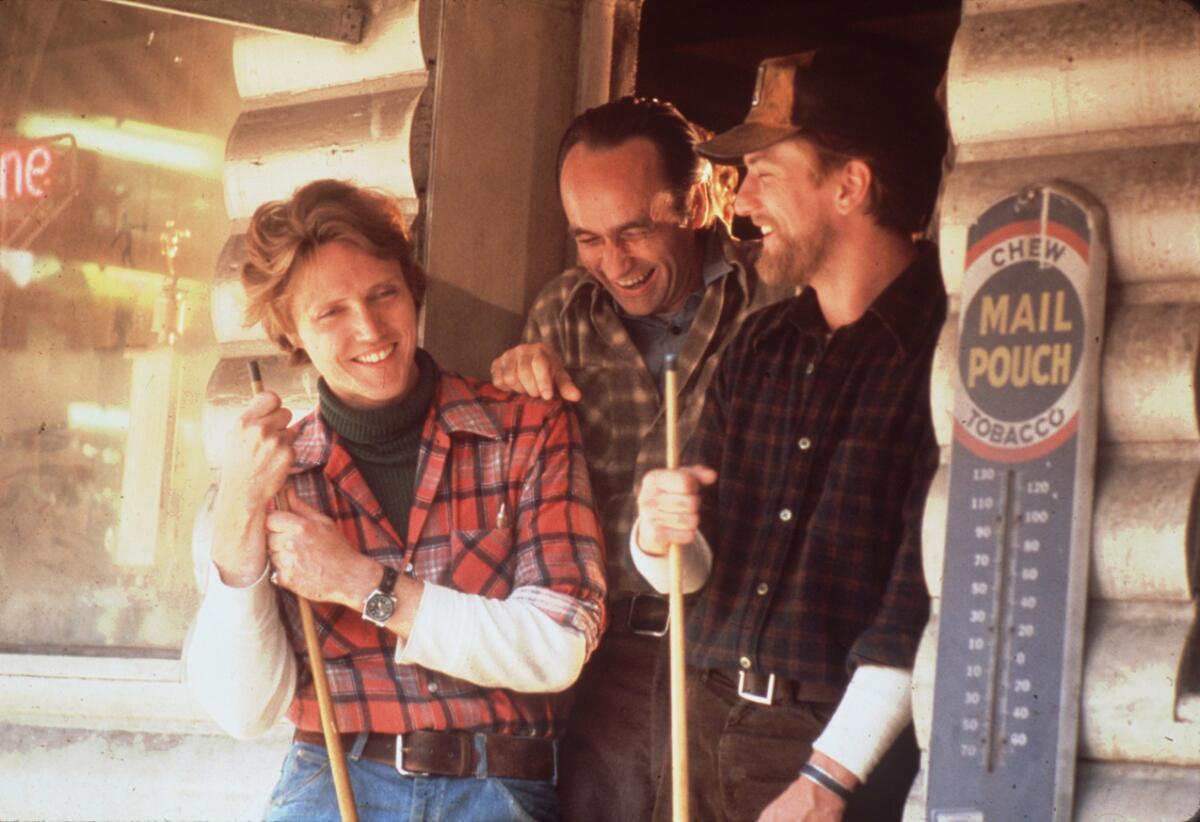
51st Academy Awards — April 1979
Rating: R.
Running time: 3 hours, 3 minutes.
Streaming: Prime Video: Rent/Buy | Apple TV+: Rent/Buy
“The Deer Hunter” is an extremely ambitious and important film on a crucial theme — the impact of the Vietnam War on American lives.
In a year in which too few movies have tried to do more than divert and pacify, “The Deer Hunter” aspires to be unique and demands to be measured against the classic uses of the screen to illustrate the way we live and die.
The best passages of Michael Cimino’s film are in fact brilliant. The American lives that will be affected by the war are drawn from a rural Pennsylvania steel mill town, and ethnic (Russian) enclave of gritty streets, hard work, desperate pleasures and tight horizons.
It is a film of excellences, never more so than in the performances by Robert De Niro and a remarkable supporting cast.
Streep is a welcome discovery, a warm and intelligent actress who somewhat recalls Faye Dunaway, and although she seems almost too good to be marking cans in the grocery store when she could make it OK in Pittsburgh or even Chicago, she is wonderfully sympathetic and understated in the role. It is obvious that she, and a name Raymond Chandler would have loved, will be heard from again.
— Charles Champlin
De Niro is Mike, one of the three millhand, deer-hunting pals who are going off to ‘Nam. Christopher Walken as Nick and John Savage as Steve are the other two. They are leaving after a beery wedding party for Savage and Rutanya Alda, who is pregnant although not necessarily by him, and then a last deer hunt with the other pals, saloonkeeper George Dzundza, John Cazale and bearded Chuck Aspergren.
Like most palships, these are not without strains. Walken is moody loner, and a complication because his girl (Meryl Streep) has eyes for De Niro as well, and vice versa.
Streep is a welcome discovery, a warm and intelligent actress who somewhat recalls Faye Dunaway, and although she seems almost too good to be marking cans in the grocery store when she could make it OK in Pittsburgh or even Chicago, she is wonderfully sympathetic and understated in the role. It is obvious that she, and a name Raymond Chandler would have loved, will be heard from again. (Read more) — Charles Champlin
1979: ‘Kramer vs. Kramer’
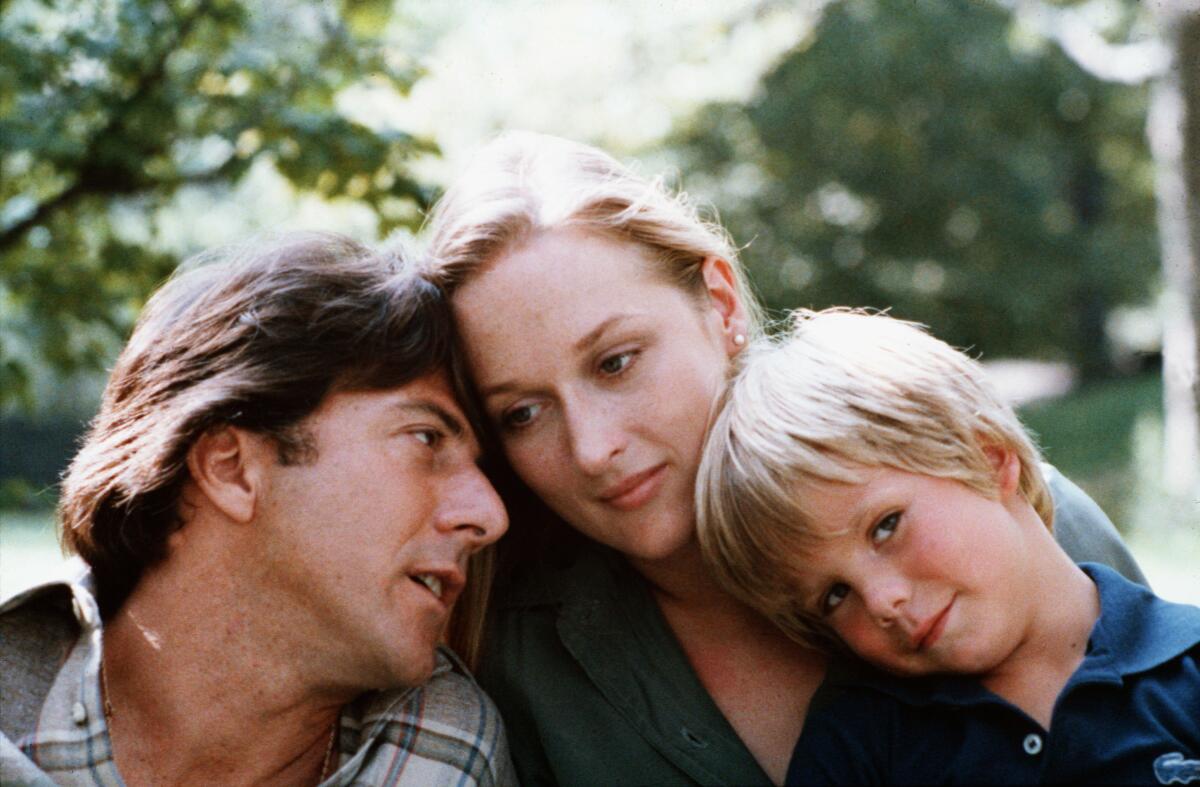
52nd Academy Awards — April 1980
Rating: PG.
Running time: 1 hour, 44 minutes.
Streaming: Prime Video: Rent/Buy | Apple TV+: Rent/Buy
Perfection comes in all sizes, skyscrapers to microcircuits. At its size and weight, “Kramer vs. Kramer” is as nearly perfect a film as can be.
From its first painterly images, of the face of Meryl Streep, sad and tender and lovely in the semidarkness, the film declares its artistry, its sensitivity and its theme. She is, as we see after a long moment, looking down at the sleeping son she is about to leave.
Avery Corman’s spare and intimate novel, about a father’s battle to retain the custody of the child he had been raising by himself, has become a motion picture with an emotional wallop second to none this year.
It is a film that seems without compromise in its insistence on the truths of its characters and their anguish, and it is, for that reason, a story without villains. It is, instead, a film about innocent casualties, some of whose wounds go deeper and are slower to heal than others.
The degree to which the principal performances by Dustin Hoffman, Streep and a glorious and spontaneous child named Justin Henry (discovered as a schoolboy, not a precocious actor) seem never to be performances at all is not less than miraculous. It bespeaks the great and probing care with which Benton and his adult actors investigated the characters, so that what happens at a crucial moment arises from a whole imagined life that the audience has not seen but can itself imagine.
Hoffman has given a number of disparate and extraordinary performances in his career but none more affecting than this one, none that seems more clearly to originate in his soul as much as in his art. (Read more) — Charles Champlin
How to watch Oscar Best Picture winners through the decades
Intro and 1920s | 1930s | 1940s | 1950s | 1960s | 1970s | 1980s | 1990s | 2000s | 2010s | 2020s (and 2020 nominees)
More to Read
Only good movies
Get the Indie Focus newsletter, Mark Olsen's weekly guide to the world of cinema.
You may occasionally receive promotional content from the Los Angeles Times.

